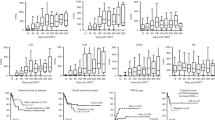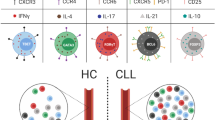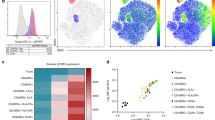Summary:
CAMPATH-1H (C-1H) is widely used in vivo and / or in vitro for T cell depletion in hematopoietic SCT. This humanised monoclonal antibody is specific for CD52, a marker coexpressed on the majority of human lymphocytes with CD48 and other glycosylphosphatidyl-inositol (GPI) anchored proteins. We detected CD52 / CD48 dual expression on >99% of CD3+ lymphocytes from normal individuals and all 15 post-SCT patients whose transplants did not utilise C-1H. By contrast, 23 / 26 patients with transplants involving C-1H (in vivo, in vitro or both) exhibited populations lacking CD52 expression that accounted for 49.7% (4.2–86.2%) of the CD3+ lymphocytes (median and range) in samples evaluated at a median of 2 months post-SCT. Most CD52− cells also lacked CD48 expression. These GPI− T cells were of either donor or mixed donor / recipient origin. They were predominant in the early months after SCT at times of profound lymphopenia and inversely correlated with the recovery of the absolute lymphocyte count (r= − 0.663, P<0.0001). The presence of CD52− cells has been correlated previously with clinical outcome after CAMPATH therapy for both malignant and nonmalignant diseases.
This is a preview of subscription content, access via your institution
Access options
Subscribe to this journal
Receive 12 print issues and online access
$259.00 per year
only $21.58 per issue
Buy this article
- Purchase on Springer Link
- Instant access to full article PDF
Prices may be subject to local taxes which are calculated during checkout





Similar content being viewed by others
References
Riechmann L, Clark M, Waldmann H, Winter G . Reshaping human antibodies for therapy. Nature 1988; 332: 323–327.
Cull GM, Haynes AP, Byrne JL et al. Preliminary experience of allogeneic stem cell transplantation for lymphoproliferative disorders using BEAM-CAMPATH conditioning: an effective regimen with low procedure-related toxicity. Br J Haematol 2000; 108: 754–760.
Morris EC, Rebello P, Thomson KJ et al. Pharmacokinetics of alemtuzumab used for in vivo and in vitro T-cell depletion in allogeneic transplantations: relevance for early adoptive immunotherapy and infectious complications. Blood 2003; 102: 404–406.
Rebello P, Cwynarski K, Varughese M et al. Pharmacokinetics of CAMPATH-1H in BMT patients. Cytotherapy 2001; 3: 261–267.
Hale G, Bright S, Chumbley G et al. Removal of T cells from bone marrow for transplantation: a monoclonal antilymphocyte antibody that fixes human complement. Blood 1983; 62: 873–882.
Gilleece MH, Dexter TM . Effect of Campath-1H antibody on human hematopoietic progenitors in vitro. Blood 1993; 82: 807–812.
Ginaldi L, De Martinis M, Matutes E et al. Levels of expression of CD52 in normal and leukemic B and T cells: correlation with in vivo therapeutic responses to Campath-1H. Leuk Res 1998; 22: 185–191.
Hale G, Xia MQ, Tighe HP et al. The CAMPATH-1 antigen (CDw52). Tissue Antigens 1990; 35: 118–127.
Richards SJ, Rawstron AC, Hillmen P . Application of flow cytometry to the diagnosis of paroxysmal nocturnal hemoglobinuria. Cytometry 2000; 42: 223–233.
Brett SJ, Baxter G, Cooper H et al. Emergence of CD52-, glycosylphosphatidylinositol-anchor-deficient lymphocytes in rheumatoid arthritis patients following Campath-1H treatment. Int Immunol 1996; 8: 325–334.
Rawstron AC, Rollinson SJ, Richards S et al. The PNH phenotype cells that emerge in most patients after CAMPATH-1H therapy are present prior to treatment. Br J Haematol 1999; 107: 148–153.
Hertenstein B, Wagner B, Bunjes D et al. Emergence of CD52-, phosphatidylinositolglycan-anchor-deficient T lymphocytes after in vivo application of Campath-1H for refractory B-cell non-Hodgkin lymphoma. Blood 1995; 86: 1487–1492.
Osterborg A, Werner A, Halapi E et al. Clonal CD8 + and CD52- T cells are induced in responding B cell lymphoma patients treated with Campath-1H (anti-CD52). Eur J Haematol 1997; 58: 5–13.
Johnson RJ, Hillmen P . Paroxysmal nocturnal haemoglobinuria: nature's gene therapy? Mol Pathol 2002; 55: 145–152.
Piedras J, Lopez-Karpovitch X . Flow cytometric analysis of glycosylphosphatidyl-inositol-anchored proteins to assess paroxysmal nocturnal hemoglobinuria clone size. Cytometry 2000; 42: 234–238.
Richards SJ, Norfolk DR, Swirsky DM, Hillmen P . Lymphocyte subset analysis and glycosylphosphatidylinositol phenotype in patients with paroxysmal nocturnal hemoglobinuria. Blood 1998; 92: 1799–1806.
Tseng JE, Hall SE, Howard TA, Ware RE . Phenotypic and functional analysis of lymphocytes in paroxysmal nocturnal hemoglobinuria. Am J Hematol 1995; 50: 244–253.
Richards SJ, Morgan GJ, Hillmen P . Analysis of T cells in paroxysmal nocturnal hemoglobinuria provides direct evidence that thymic T-cell production declines with age. Blood 1999; 94: 2790–2799.
Bindon CI, Hale G, Waldmann H . Importance of antigen specificity for complement-mediated lysis by monoclonal antibodies. Eur J Immunol 1988; 18: 1507–1514.
Cornish JM, Pamphilon DH, Potter MN et al. Unrelated donor bone marrow transplant in childhood ALL. The role of T-cell depletion. Bone Marrow Transplant 1996; 18 (Suppl 2): 31–35.
Oakhill A, Pamphilon DH, Potter MN et al. Unrelated donor bone marrow transplantation for children with relapsed acute lymphoblastic leukaemia in second complete remission. Br J Haematol 1996; 94: 574–578.
Chakrabarti S, Milligan DW, Brown J et al. Influence of cytomegalovirus (CMV) sero-positivity on CMV infection, lymphocyte recovery and non-CMV infections following T-cell-depleted allogeneic stem cell transplantation: a comparison between two T-cell depletion regimens. Bone Marrow Transplant 2004; 33: 197–204.
Hancock JP, Burgess MF, Goulden NJ et al. Same-day determination of chimaeric status in the immediate period following allogeneic bone marrow transplantation. Br J Haematol 1997; 99: 403–409.
Hancock JP, Goulden NJ, Oakhill A, Steward CG . Quantitative analysis of chimerism after allogeneic bone marrow transplantation using immunomagnetic selection and fluorescent microsatellite PCR. Leukemia 2003; 17: 247–251.
Nakakuma H, Nagakura S, Kawaguchi T et al. Persistence of affected T lymphocytes in long-term clinical remission in paroxysmal nocturnal hemoglobinuria. Blood 1994; 84: 3925–3928.
Ware RE, Pickens CV, DeCastro CM, Howard TA . Circulating PIG-A mutant T lymphocytes in healthy adults and patients with bone marrow failure syndromes. Exp Hematol 2001; 29: 1403–1409.
Tuset E, Matutes E, Brito-Babapulle V et al. Immunophenotype changes and loss of CD52 expression in two patients with relapsed T-cell prolymphocytic leukaemia. Leuk Lymphoma 2001; 42: 1379–1383.
Poynton CH, Shaw PJ, Barrett AJ . Leukaemic relapse associated with phenotypic change after CAMPATH-1 purged autologous bone marrow transplantation. Lancet 1986; 1: 162.
Birhiray RE, Shaw G, Guldan S et al. Phenotypic transformation of CD52(pos) to CD52(neg) leukemic T cells as a mechanism for resistance to CAMPATH-1H. Leukemia 2002; 16: 861–864.
Taylor VC, Sims M, Brett S, Field MC . Antibody selection against CD52 produces a paroxysmal nocturnal haemoglobinuria phenotype in human lymphocytes by a novel mechanism. Biochem J 1997; 322: 919–925.
Brett S, Baxter G, Cooper H et al. Repopulation of blood lymphocyte sub-populations in rheumatoid arthritis patients treated with the depleting humanized monoclonal antibody, CAMPATH-1H. Immunology 1996; 88: 13–19.
Bunjes D, Theobald M, Wiesneth M et al. Graft rejection by a population of primed CDw52-host T cells after in vivo / ex vivo T-depleted bone marrow transplantation. Bone Marrow Transplant 1993; 12: 209–215.
Chakrabarti S, Mackinnon S, Chopra R et al. High incidence of cytomegalovirus infection after nonmyeloablative stem cell transplantation: potential role of Campath-1H in delaying immune reconstitution. Blood 2002; 99: 4357–4363.
Acknowledgements
This work was funded by a grant from the COGENT trust. We acknowledge the assistance of the nursing staff of the BMT Unit and Oncology Day Beds in obtaining blood samples for use in this study. This work would not have been possible without the agreement of the patients to participate, to whom we are deeply indebted.
Author information
Authors and Affiliations
Corresponding author
Rights and permissions
About this article
Cite this article
Garland, R., Groves, S., Diamanti, P. et al. Early emergence of PNH-like T cells after allogeneic stem cell transplants utilising CAMPATH-1H for T cell depletion. Bone Marrow Transplant 36, 237–244 (2005). https://doi.org/10.1038/sj.bmt.1705049
Received:
Accepted:
Published:
Issue Date:
DOI: https://doi.org/10.1038/sj.bmt.1705049



